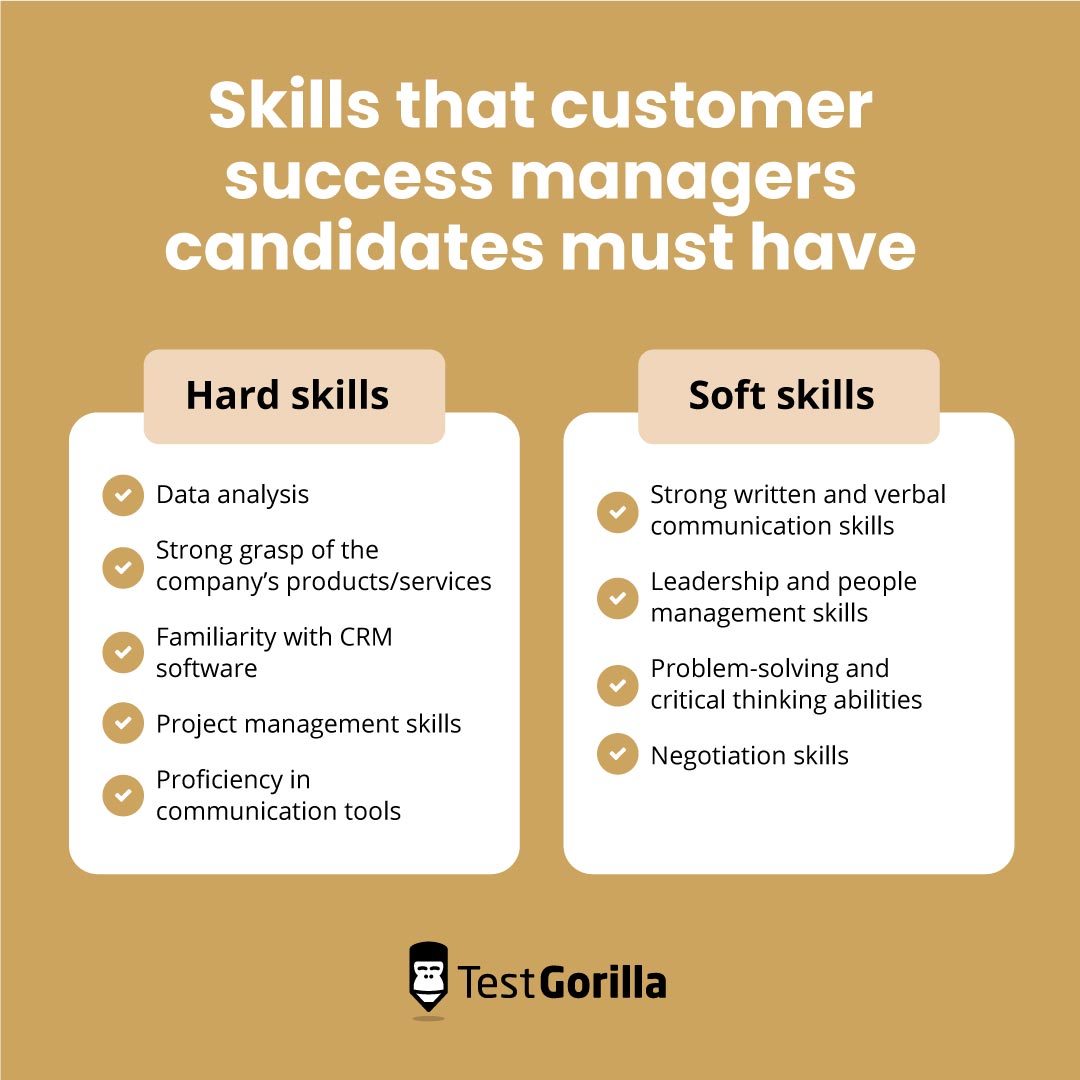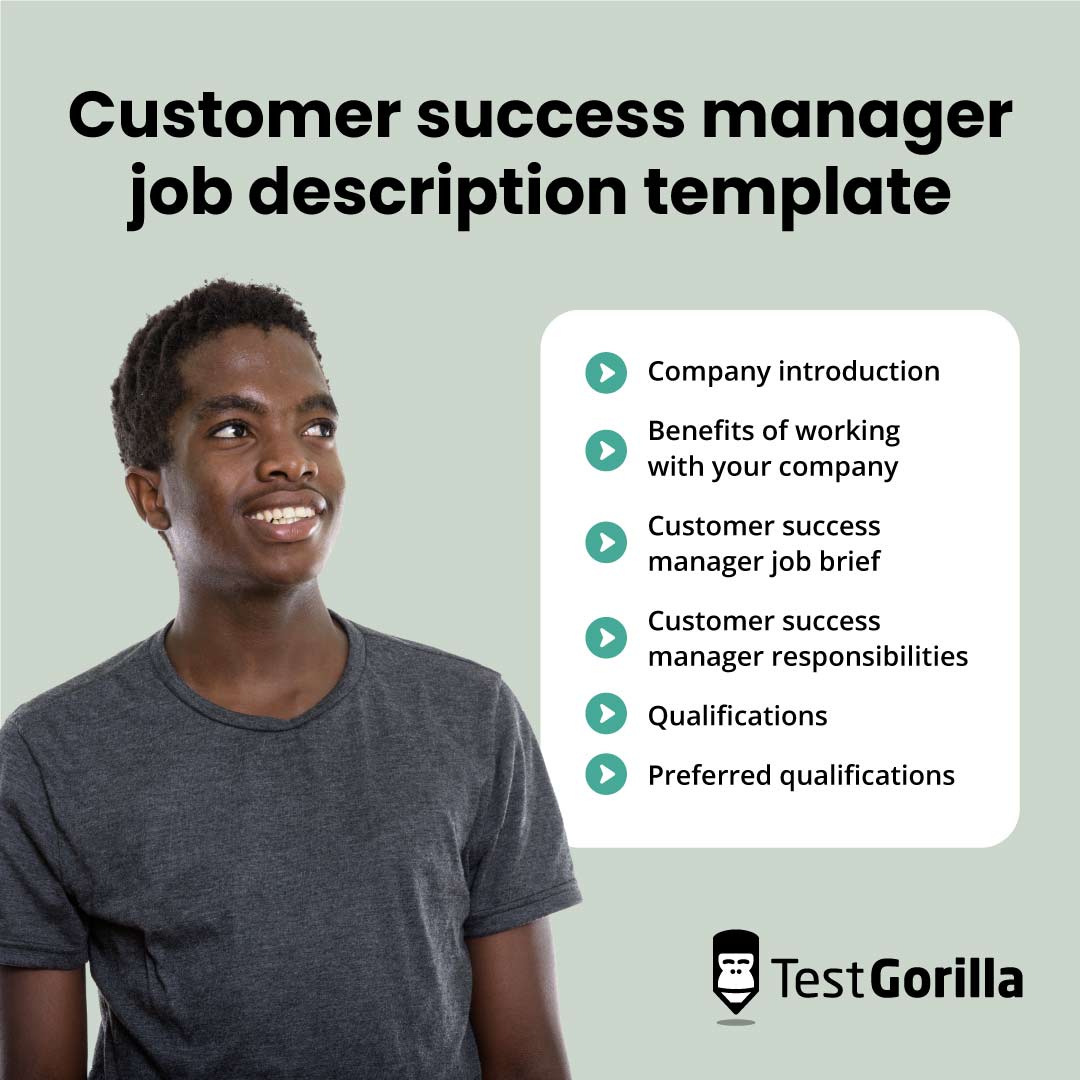Many customer success manager job descriptions don’t accurately reflect the role’s duties. They’re often exclusively focused on effective customer communication, leading to high volumes of unqualified applicants for the position. I
n reality, customer success managers do much more than that and need a solid set of hard and soft skills to succeed.
A well-written job description provides a complete picture and specifies the exact requirements for the customer success manager role so you don’t end up with countless unqualified applications to sift through.
In this guide, we show you how to write an effective customer success manager job description. We also share a free job description template so you can get started quickly.
Table of contents
- What is a customer success manager?
- Key skills to look for in customer success managers
- How to write an effective customer success manager job description
- Customer success manager job description template
- 3 things to avoid when writing a job description for customer success managers
- Next steps: Attracting and assessing customer success managers
- FAQs
- Hiring the best customer success managers with TestGorilla
What is a customer success manager?
A customer success manager (CSM) ensures a company’s customers have a positive experience with its products or services. They do this through relationship building and management, customer engagement, feedback collection, advocacy, and more. The primary goal of a customer success manager is to promote customer retention and loyalty.
Customer success managers commonly work for companies with subscription-based models, software as a service (SaaS) companies, and other organizations where building long-term relationships with customers is essential for business growth. They usually bridge the gap between customers and a company’s internal teams, such as sales and product development.
Key skills to look for in customer success managers
The skills your customer success manager needs will depend on your company’s unique objectives. But any good candidate should possess the following hard and soft skills.
Hard skills
Data analysis to monitor key customer metrics, identify trends, and make data-driven decisions using tools like Google Analytics and Microsoft Excel
Strong grasp of the company’s products or services to understand customer needs and provide solutions
Familiarity with customer relationship management (CRM) software such as Zendesk, Salesforce, and HubSpot
Project management skills and experience with tools like Trello and Asana to handle multiple customer accounts, stay organized, and meet deadlines
Proficiency in communication tools like email, messaging platforms, video conferencing, and feedback platforms like Qualtrics and SurveyMonkey
Soft skills
Strong written and verbal communication skills to understand and interact with customers and relay insights to cross-functional teams
Leadership and people management skills to effectively lead a team of customer success specialists
Problem-solving and critical thinking abilities to identify issues, analyze information, and find impactful solutions
Negotiation skills to resolve conflicts with customers and advocate for prioritizing customer needs within the company
The best insights on HR and recruitment, delivered to your inbox.
Biweekly updates. No spam. Unsubscribe any time.
How to write an effective customer success manager job description
The best practices below can help you write more effective customer success job descriptions.
Customize it and be specific
Tailor your job description to reflect your specific company needs. For instance, if you’re looking for someone experienced with HubSpot, specify this requirement rather than writing something generic like “knowledge of CRM tools.”
Also, be particular about other critical needs for the role. This could be proficiency in a specific language or flexibility to travel.
Make it stand out
Use relevant keywords such as “CSM job description” or “customer satisfaction” so your job description has more visibility than your competitors’ job ads. Several websites can help provide you with suitable and effective keywords to use.
Additionally, sell the role to candidates. Write about your company and why it’s the ideal place to work for customer success managers. You can also touch on employee benefits and perks, such as paid personal days off and health insurance plans, to attract top talent.
Use a template
Using a template can help provide a solid, concise base to start writing your customer success manager job description. It can also give you a better understanding of what skills to look for and save you a ton of time and effort.
Customer success manager job description template
Here’s a job description template you can use to advertise your customer success manager role.
Company introduction
Provide a brief overview of your company, including its name, mission, and products or services. Additionally, describe your organization’s recent accomplishments and spotlight why it’s a leader in your industry.
Benefits of working with [your company]
Outline your company’s benefits programs, such as health insurance and 401k plans. Also, mention non-monetary perks like flexible working, mental health days, and free gym memberships.
Customer success manager job brief
[Company name]
Job Title: [For example, Customer Success Manager or Senior Customer Success Manager]
Reports to: [For instance, Chief Product Officer or Head of Customer Experience]
Position type: [For example, full-time, part-time, or independent contractor]
Location: [Remote, hybrid, or on-site]
[Salary and benefits details]
Customer success manager responsibilities
Guide new customers through the onboarding process, ensuring a smooth transition to [product or service]
Proactively engage with customers to evaluate their satisfaction, identify potential issues, and enhance their experience with [product or service]
Develop a deep understanding of [product or service] to address customer concerns and provide guidance effectively
Gather and analyze customer feedback to identify trends, monitor customer health, and make data-driven decisions
Collaborate with sales and product development teams to ensure customer preferences and feedback are incorporated into every aspect of business
Qualifications
Bachelor’s degree in communications, psychology, computer science, or a related field – OR equivalent work experience
At least three years’ experience in customer success or similar roles
Preferred qualifications
Proficient with Salesforce and HubSpot
Prior experience working with Qualtrics
Strong verbal and written communication skills
3 things to avoid when writing a job description for customer success managers
Look out for these common mistakes when writing your job description.
Not discussing soft skill requirements
In addition to technical skills, specify which soft skills, personality traits, and cognitive abilities are key to succeeding as a customer success manager at your company. Otherwise, you could select a candidate who’s great with HubSpot but has subpar communication skills, which would be problematic for this role.
Using discriminatory language
Avoid using discriminatory language in your job description. This context means any wording that implies that the role is only for candidates with a specific gender, age, ethnicity, sexual orientation, or other protected characteristics.
For example, don’t say, “We’re looking for a young, innovative customer success manager to join our team,” as you’ll likely lose a large pool of more experienced candidates who may be a good fit for the role.
Overcomplicating the job description
Try not to make your customer success manager job description too long or overloaded with unnecessary information, as this can deter applicants from reading it attentively.
Additionally, avoid using too many acronyms or other jargon that not all candidates will be familiar with. For instance, your company may refer to customer satisfaction scores as “CSAT scores.” But this may not be true for everyone in the industry and could stop some qualified candidates from applying for the role if they don’t understand it.
Next steps: Attracting and assessing customer success managers
Well-written job descriptions are critical to attracting the right candidates, but alone, they aren’t enough to weed out unqualified applicants. The most effective way to screen and assess your customer success manager applicants is through pre-employment testing.
With TestGorilla, you can access 300+ tests to evaluate your candidates’ hard and soft skills quickly and objectively.
Consider putting candidates through these customer success manager tests before progressing their application.
TestGorilla’s Customer Success Manager (SaaS) test and Customer Service test to assess technical abilities for the role
Our Zen desk CS, Hubspot CRM, and Salesforce CRM tests to measure candidates’ proficiency with these tools
The Communication skills, verbal reasoning, language, and email skills tests to ensure candidates can communicate effectively with customers
Critical thinking and problem-solving assessments to evaluate how effectively candidates can analyze information and provide solutions
The DISC or Enneagram Personality tests and the Culture add test to determine if candidates’ core traits are right for the role and your company
The Customer Service test to evaluate their ability to interact appropriately with customers and determine appropriate solutions to their issues
Plus, you can add your own customer success interview questions to assessments to evaluate candidates based on even more criteria.
FAQs
Should I include customer success KPIs in the job description?
You shouldn’t include specific customer service KPIs (key performance indicators) such as net promoter scores (NPS) and average revenue per customer targets in the job description. This is because KPIs can feel daunting without context. However, you can state that candidates should have experience working with these KPIs and their related tools.
What’s the difference between customer success managers and account managers?
In some companies, certain aspects of account management can fall under customer success management, but the roles are different.
Customer success managers build and maintain long-term customer relationships – helping them derive maximum value from a product or service. Meanwhile, account managers focus on growing account revenues, cross-selling and up-selling, and encouraging renewals.
Hiring the best customer success managers with TestGorilla
Customer success managers are tasked with improving customer satisfaction, loyalty, and retention and require a specialized set of hard and soft skills. A well-written job description clearly outlining the job and its requirements is the first step to attracting the right candidates for this role.
Pre-employment testing is a great way to filter the applications you receive and identify top candidates. TestGorilla provides a range of tests – including job-specific skills tests, cognitive ability assessments, personality and culture tests, and more – so you can thoroughly assess your customer success manager candidates before hiring them.
Create a free account, schedule a live demo, or take a quick product tour to explore everything TestGorilla offers.
You've scrolled this far
Why not try TestGorilla for free, and see what happens when you put skills first.




















